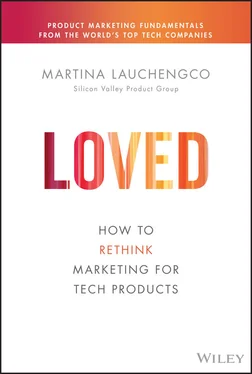A competitor hadn't even released a product but wrote about their point of view so well and often, if people searched for a solution, this competitor's points of view topped all search results. They were perceived as the market leader before they even shipped a product.
A company in an adjacent category put on an event that got press coverage promoting features the category-leading company didn't have. It left them scrambling to respond with their sales team and in public forums, making them look like they were playing catch-up, even though they were the category leader.
In each of these examples, the company's product was unchanged. Yet the market reality very much had. While you can't let the competition dictate your course of action, you can't ignore how much they can shape perceptions .
That said, beware of over-rotating toward competitive response. Companies can lose their own way if overly responsive to competitors' agendas rather than staying focused on what's best for their customers or market. This is a place where product marketing response can and should be much more dynamic than product's.
Meet challenge with challenge. Outplay the competition whenever you can. But think of this as chess; move ahead of your competition, don't just respond.
Product marketing helps the company stay the course for what is most important and exercise judgment on what merits response.
Product marketing is the ambassador for all these customer and market insights, so they must be a part of the right internal conversations. They can accelerate a product feature or make sure an engineering blog gets written to diminish a competitor's approach. Product marketing directs appropriate response, whether it's through product, marketing, or sales.
Customer insights can sometimes be heard as customer requirements. These are two distinct things. When product marketers bring customer or market insights to a product team, it's important to see them for what they are—a way for the team to make smarter decisions based on market realities, not just technical ones. How any insight impacts product priorities falls to the product manager to decide.
Customer insights also often get translated into artifacts—like Jobs to Be Done (JTBD) stories (often used by product), Personas (often used by design or product), Ideal Customer Profile (ICP, often used by sales), and customer segmentations (often used by marketing). Each has a purpose that is specific to the function.
For example, an ICP might have overlap with problems the customer is trying to solve in a JTBD story. But the ICP is used to determine account fit and likelihood to buy, a function of the technologies already in use, the size of the organization, budget availability, and the presence of an internal champion—none of which appears in a JTBD story.
As the ambassador for customer and market realities, the product marketer ensures the most important attributes that drive customer and market adoption are known and documented so teams can do their jobs better.
Market and customer insights can add gas to a burning marketing fire. Anything in customers' daily lives, news, or trends can be a propellant if the right moment is seized.
That's why a deep understanding of customers and markets is Fundamental 1 of product marketing. It is simply the foundation on which everything in a product's go-to-market gets built.
Chapter 4 Strategist: Direct Your Product's Go-to-Market
The launch of Pocket 4.0 set the small company on a totally different trajectory. Nate, now CEO of a venture-backed startup, was up at the white board as the team gathered to solve the problem of how to follow 4.0. His marker squeaked as he wrote 5.0's key features on the wall-sized canvas. The affable CTO stared at the whiteboard and asked, “How do we make all this matter?”
Unlike B2B companies, where an analyst can anoint a company “leader” and shape its future, the fate of a consumer app like Pocket's lies in the hands of ordinary people. An app can have a moment but then fade. The team needed a way to boost and grow people's interest. And they needed something press-worthy to compete with hundreds of thousands of other apps vying for attention.
Crowded into the sole conference room with a window, Nate wrote the marketing strategies guiding Pocket on the whiteboard: grow a loyal user base, define and lead the category, and leverage partnerships for growth. Using them as guides to judge each idea, the team agreed an online launch like 4.0's wasn't enough. It wouldn't define the category nor elevate Pocket's importance to potential partners. They needed something that let them tell the whole story of why saving Internet content to view later enabled mobile lifestyles and was good for content creators.
The solution came in an idea internally called Pocket Matters. It was an in-person 5.0 launch event with press, partners, and 10 Pocket users at a San Francisco wine bar. Nate gave a presentation that told the story: long-form content had an avid audience when you let people save and view it later—which is why Pocket mattered—and then introduced 5.0's highlights to the world. They shared a digital media kit for journalists summarizing everything being announced. Partners, customers, and press mingled with one another before and after the event.
Within hours of the event, they had a flurry of press, downloads, and partner discussions that accelerated. Less than a month after the event, Nate was also named one of Time Magazine's 30 People Under 30 Changing the World.
While the event helped with all of their strategies, its purpose was to define and lead the category. This clarity helped them make smart go-to-market decisions with better results . It's why being a strategist that directs a thoughtful approach to a product's go-to-market is Fundamental 2 of product marketing.
Throughout this book, I refer to a set of concepts around go-to-market and strategy that, out in the real world, are used loosely. For the purpose of this book, I'll now explain what I mean whenever I use terms and how they interrelate. I'll also mention how others refer to them to help clear up what I know can be confusing.
Go-to-Market (GTM) Engine, aka marketing and sales, GTM strategy. This is the sum total of all the marketing and sales machinery that bring products to market.At scale, it's an engine that picks and chooses how it leverages products. Because marketing and sales activities exist outside any individual product's go-to-market, the term go-to-market can't be presumed to be associated with a particular product. In this book, I'll refer to this as the GTM engine (my term) because it crosses functions and organizations and to avoid confusion with other uses of GTM.
Marketing Strategy, aka GTM Strategy. This drives the orchestration of the marketing elements in the GTM engine, for example, brand, corporate communications, demand generation, or promotional programs. This is owned by the marketing team at large at the company level.At the level of an individual product, marketing strategies are driven by the product marketer to create alignment in a product go-to-market plan, where specific activities, how they get done, and dates come together. For most one-product companies, marketing strategies and a product's marketing strategies are largely one and the same.
Product Go-to-Market. If you're familiar with other SVPG work, go-to-market means for a particular product. But since this book places that work into a company's larger go-to-market context, I will refer to a product go-to-market—the unique purview of product marketing—when I mean the path for how a particular product goes to market.
Читать дальше












